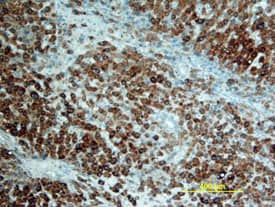Human RANK/TNFRSF11A Antibody
R&D Systems, part of Bio-Techne | Catalog # MAB6831

Key Product Details
Species Reactivity
Validated:
Cited:
Applications
Validated:
Cited:
Label
Antibody Source
Product Specifications
Immunogen
Leu28-Gly213
Accession # Q9Y6Q6
Specificity
Clonality
Host
Isotype
Scientific Data Images for Human RANK/TNFRSF11A Antibody
RANK/TNFRSF11A in Human Liver.
RANK/TNFRSF11A was detected in immersion fixed paraffin-embedded sections of human liver using Mouse Anti-Human RANK/TNFRSF11A Monoclonal Antibody (Catalog # MAB6831) at 25 µg/mL overnight at 4 °C. Tissue was stained using the Anti-Mouse HRP-DAB Cell & Tissue Staining Kit (brown; Catalog # CTS002) and counterstained with hematoxylin (blue). View our protocol for Chromogenic IHC Staining of Paraffin-embedded Tissue Sections.Applications for Human RANK/TNFRSF11A Antibody
Immunohistochemistry
Sample: Immersion fixed paraffin-embedded sections of human liver
Western Blot
Sample: Recombinant Human RANK/TNFRSF11A Fc Chimera (Catalog # 683-RK)
Formulation, Preparation, and Storage
Purification
Reconstitution
Formulation
Shipping
Stability & Storage
- 12 months from date of receipt, -20 to -70 °C as supplied.
- 1 month, 2 to 8 °C under sterile conditions after reconstitution.
- 6 months, -20 to -70 °C under sterile conditions after reconstitution.
Background: RANK/TNFRSF11A
RANK (receptor activator of NF-kappa B, also known as TRANCE receptor, osteoclast differentiation factor receptor [ODFR]) and TNFRSF11A is a member of the tumor necrosis factor receptor family. The full length human RANK cDNA encodes a type I transmembrane protein of 616 amino acids with a predicted 184 amino acid extracellular domain and a 383 amino acid cytoplasmic domain. The extracellular domain contains two potential N-linked glycosylation sites. RANK shares significant amino acid homology with other members of the TNF R family in its extracellular four cysteine-rich repeats. Human and murine RANK share 81% amino acid identity in their extracellular domains. RANK is widely expressed with highest levels in skeletal muscle, thymus, liver, colon, small intestine and adrenal gland. RANK is expressed in dendritic cells. In activated human peripheral blood T lymphocytes, RANK expression is induced by IL-4 and TGF-beta. Multiple tumor necrosis factor receptor-associated factors (TRAFs) are involved in the signaling of RANK. TRANCE (TNF-related activation-induced cytokines, also known as RANK ligand [RANKL], osteoprotegerin ligand [OPGL], and osteoclast differentiation factor [ODF]) is the ligand for RANK. The biological functions mediated through RANK include activation of NF-kappa B and c-jun N-terminal kinase, enhancement of T cell growth and dendritic cell function, induction of osteoclastogenesis, and lymph node organogenesis. Soluble RANK is able to block TRANCE induced biological activity.
References
- Anderson, D.M. et al. (1997) Nature 390:175.
- Nakagawa, N. et al. (1998) Biochem. Biophys. Res. Commun. 245:382.
Long Name
Alternate Names
Gene Symbol
UniProt
Additional RANK/TNFRSF11A Products
Product Documents for Human RANK/TNFRSF11A Antibody
Product Specific Notices for Human RANK/TNFRSF11A Antibody
For research use only
